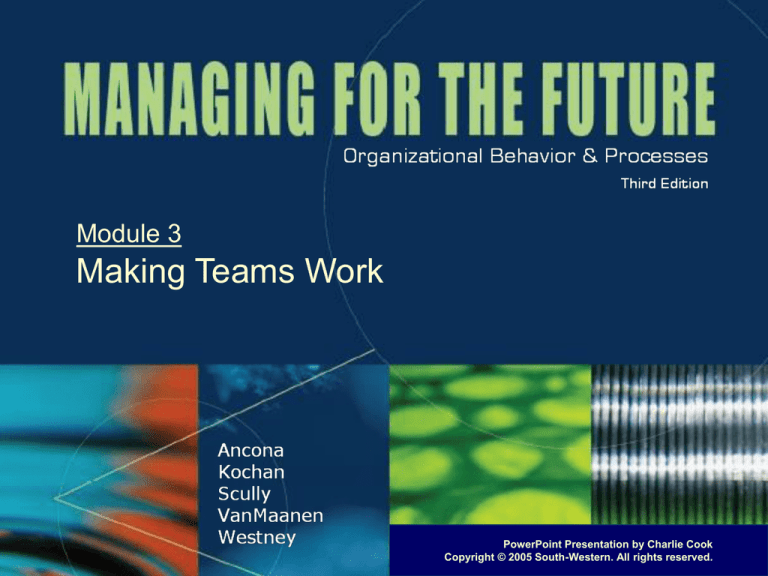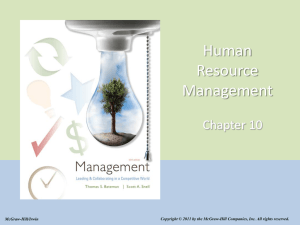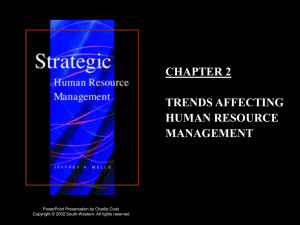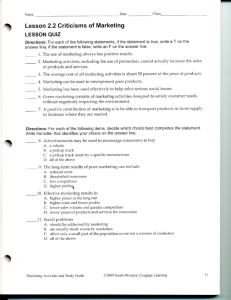
Module 3
Making Teams Work
PowerPoint Presentation by Charlie Cook
Copyright © 2005 South-Western. All rights reserved.
Key Terms
• Working group
A small set of individuals who are aware of each other,
interact with one another, and who have a sense of
themselves together as a unit
• Team
Has all of the characteristics of a working group in
addition to having members working interdependently
and being jointly accountable for performance goals
Class Notes: A Team Primer
Copyright © 2005 South-Western. All rights reserved.
3–2
Key Terms (cont’d)
• High-performing teams
Excel in several categories of team effectiveness—
performance, member satisfaction, team learning,
outsider satisfaction
• Hot groups
Refers to a state of mind that exists in groups or teams
whose members are motivated to stretch themselves
to new levels
Class Notes: A Team Primer
Copyright © 2005 South-Western. All rights reserved.
3–3
Key Terms (cont’d)
• Teamwork
A set of values whereby members of some collective
(a group, team, division, or organization) are
encouraged to help one another, to listen and give
feedback to others, and to provide support and
recognition to others
• Team player
A member of some collective (a group, team, division,
or organization) who embodies teamwork values
Class Notes: A Team Primer
Copyright © 2005 South-Western. All rights reserved.
3–4
Types of Teams
• Quality circles (QCs)
Small groups of employees who get together to solve
quality-related problems such as quality control, cost
reduction, and production planning
• Cross-functional teams
Consist of members that represent multiple functions
within the firm, who work together to improve the
coordination among functions in such areas as product
development, process improvement, and allocation of
resources
Class Notes: A Team Primer
Copyright © 2005 South-Western. All rights reserved.
3–5
Types of Teams (cont’d)
• Self-managed teams (autonomous work groups)
Make decisions and have the responsibility to hire
members, allocate tasks and roles, determine work
schedules and work flow, and handle disputes
• Office of the president
The set of executives who run a corporation—the
functional or divisional managers report directly to the
CEO, manage internal operations, and help the CEO
formulate strategy and manage external relations
Class Notes: A Team Primer
Copyright © 2005 South-Western. All rights reserved.
3–6
Types of Teams (cont’d)
• Transnational team
Composed of people from different countries whose
activities cross multiple borders
• Virtual team
Composed of members who rely on electronic tools
such as e-mail, fax, voice mail, videoconferencing, and
“virtual workspaces” to communicate with each other
Class Notes: A Team Primer
Copyright © 2005 South-Western. All rights reserved.
3–7
Teams versus Individuals
• Teams pro and con:
Teams promise greater competitiveness, faster
decision making, fewer levels of hierarchy, greater
commitment and quality, greater employee satisfaction
Teams may also be difficult to manage, evaluate, and
support
• Creating teams requires investment in training
and organizational design
• Work structured for individuals often takes less
time and gives workers a greater sense of control
Class Notes: A Team Primer
Copyright © 2005 South-Western. All rights reserved.
3–8
Teams versus Individuals (cont’d)
• Use a team approach when
Work requires a range of different skills, views, or
expertise
Different work components are highly interdependent
Sufficient time is available to organize and structure
team effort
Organizational reward structure and culture support a
team approach
Class Notes: A Team Primer
Copyright © 2005 South-Western. All rights reserved.
3–9
Teams versus Individuals (cont’d)
• Use a team approach when (cont’d)
Need is identified to build commitment to a course of
action or set of decisions
Issues being worked on require refinement
Needs are high for innovation and coordination
Members can be trusted not to purposefully obstruct
team’s efforts
Individuals desire a team experience
Class Notes: A Team Primer
Copyright © 2005 South-Western. All rights reserved.
3–10
Components of Team Effectiveness
• Performance
How well team members produce output, measured in
terms of quality, quantity, timeliness, efficiency, and
innovation
• Member satisfaction
How well team members create a positive experience
through commitment, trust, and meeting individual
needs
Class Notes: A Team Primer
Copyright © 2005 South-Western. All rights reserved.
3–11
Components of Effectiveness (cont’d)
• Team learning
How well team members can acquire new skills,
perspectives, and behaviors as needed by changing
circumstances
• Outsider satisfaction
How well team members meet the needs of outside
constituencies
Class Notes: A Team Primer
Copyright © 2005 South-Western. All rights reserved.
3–12
Model of Team Effectiveness
Class Notes: A Team Primer
Copyright © 2005 South-Western. All rights reserved.
Figure 3.1
3–13
Team Operations
• Internal team processes
The ways in which team members interact with each
other to accomplish the task and to keep themselves
together as a team
• Boundary management
The way in which teams define their boundaries,
identify key external constituencies, and interact with
those outsiders
Class Notes: A Team Primer
Copyright © 2005 South-Western. All rights reserved.
3–14
Team Context
• Organizational culture
The values and underlying assumptions of an
organization communicated through symbols, stories,
and rituals
• Team design
The way in which teams are put together, including
their composition, the nature of their task, and their
structure
Class Notes: A Team Primer
Copyright © 2005 South-Western. All rights reserved.
3–15
Team Context (cont’d)
• Rewards
Formal and informal benefits given for individual and
team performance act as a key determinant of how
team members will interact with one another and those
outside the team
Class Notes: A Team Primer
Copyright © 2005 South-Western. All rights reserved.
3–16
Overview
• Team effectiveness is enhanced when team
members answer five important questions:
1.
2.
3.
4.
5.
Who are we?
What do we want to accomplish?
How can we organize ourselves to meet our goals?
How will we operate?
How can we continuously learn and improve?
Handbook
Copyright © 2005 South-Western. All rights reserved.
3–17
I. Who Are We?
• Team must begin by coming to terms with its
composition
• To begin the process of getting to know each
other:
Ask team members to share basic personal
information and previous team experience
Discuss responses as a team
Discuss how the team can capitalize on similarities
and differences among team members
Handbook
Copyright © 2005 South-Western. All rights reserved.
3–18
II. What Do We Want to Accomplish?
• Team members must first agree on goals
• Categories of team goals:
Performance—the team’s output
Member satisfaction—providing team members with a
positive experience
Team learning—developing the team’s ability to
survive, improve, and adapt to changing
circumstances
Outsider satisfaction—meeting the demands of, and
pleasing, outside constituencies
Handbook
Copyright © 2005 South-Western. All rights reserved.
3–19
III. How Can We Organize Ourselves?
• Three major aspects are involved in organizing a
team:
Creating a work structure requires that the team move
from the goals to the work that needs to be done to
achieve those goals
Roles are specific activities taken on by particular
individuals: facilitator, project manager, and boundary
manager
Norms refer to expectations of acceptable behavior;
they are unwritten rules enforced by team members
Handbook
Copyright © 2005 South-Western. All rights reserved.
3–20
III. How Can We Organize (cont’d)
• Teams must discuss and agree upon norms
• Categories of norms:
Meeting norms—when, were, and how often to meet
Working norms—standards, deadlines, distribution of
effort and work
Communication norms—when communication should
take place and who is responsible
Leadership norms—whether a leader is needed
Consideration norms—being considerate of members’
comfort with smoking, swearing, etc.
Handbook
Copyright © 2005 South-Western. All rights reserved.
3–21
IV. How Will We Operate?
• When planning an agenda:
Write down the major items that the team wishes to
tackle
Ensure that all team members have the opportunity to
contribute
Clarify what the team wants to accomplish for each
item—discussion, brainstorming, making a decision,
taking action, etc.
Prioritize items and allocate time to each
Leave time at the end to discuss how the meeting
went
Handbook
Copyright © 2005 South-Western. All rights reserved.
3–22
V. How Can We Learn and Improve?
• When giving feedback, describe problem and
how it affects you and the team
• Feedback should:
Be specific, not general
Describe behavior, not judge the person
Start with the word I, not the word you (to avoid
blaming)
Be timely
Handbook
Copyright © 2005 South-Western. All rights reserved.
3–23
V. How Can We Learn (cont’d)
• When assessing yourself or the team, ask these
questions:
Goals—Are my and our goals being met?
Roles and structure—What are our roles? What works
or doesn’t work in our team structure?
Process—How effectively do we make decisions and
resolve conflict?
Plans to change—How can we improve any of these
areas?
Handbook
Copyright © 2005 South-Western. All rights reserved.
3–24
Individual Analysis of Team
Step 1:
Step 2:
Step 3:
Step 4:
Step 5:
Collect Some Data
Find an Efficient Way to Present Data
Analyze the Team’s Internal Process
Analyze Your Own Behavior
Provide Suggestions for What the Team
Can Do to Improve Its Performance
Step 6: Provide Suggestions for How the Team
Can Change
Handout 3.2
Copyright © 2005 South-Western. All rights reserved.
3–25





